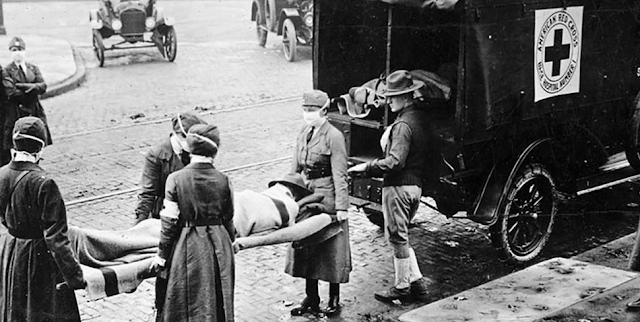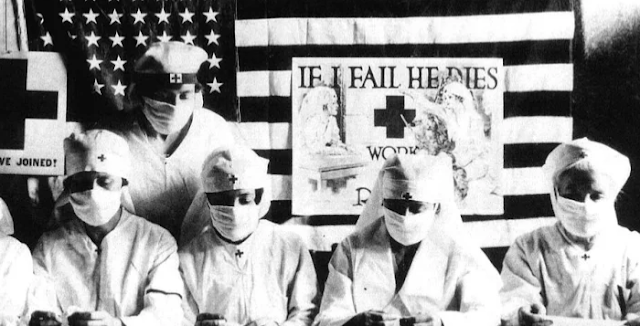Hey Guys!
We hope you guys doing good today. Everyone should know about the deadly flu in India before corona virus. We are here with topic Spanish flu in India. We are going to discuss in detail about Spanish flu in India. Before that, we all should know what is Spanish flu? Where it begin ? Where it is ended?
An estimated fifty million people died during the Spanish Flu pandemic from 1918 to 1920. Many have drawn comparisons between that pandemic and the current pandemic. During Spanish flu in India many people lost their lives this is main reason for India to fall Population.
Spanish flu in India
But how much do you really know about the 1918 flu pandemic?
Some historians have described the Spanish flu 1918 as one of the deadliest pandemics in modern history – it infected and killed millions of people indiscriminately, including people who had previously been thought healthy and safe from viruses. Although the effects of this pandemic still linger in modern society, history has bypassed this pandemic because it came at the end of World War I.
The troops coming home from the war accidentally brought back a virus that would fuel public panic, lockdowns, and more deaths than they had seen on the battlefields.
How did the 1918 flu pandemic begin?
Despite the misnomer, the Spanish flu did not originate in Spain; instead, some historians have hypothesized that it began in America, Europe, or areas of Asia before it spread internationally. The disease has been misnamed because Spain was one of the neutral countries during World War I – their press did not have any wartime censorship, so they reported freely on the virus as it began to wreak havoc on the country.
Other countries were experiencing the effects of the virus, but their press was not allowed to report on anything that might dampen morale. Spain’s lack of censorship made it appear that the virus had begun in Spain, which is how the pandemic got its name.
The Spanish were not responsible for the Spanish flu or the widespread impact of the disease – the military appears to have been the first severe spreaders of this illness, and they brought it home from the war. Some argue that it began in Kansas because the first known case was recorded there. Regardless of where it started, the pandemic was caused by an H1N1 virus that possibly had avian origins. It was transmitted in the air, and the unsanitary living conditions at the time aided the transmission of the disease. Soldiers in the trenches were packed so tightly that the virus had a perfect place to mutate.
Militaries were also moving quickly across the globe, and the tightly packed, malnourished soldiers unknowingly carried the disease with them. The living conditions were not much cleaner back home, especially in the cities. People lived so closely together that illnesses could quickly spread from one person to another, increasing both the risk of exposure and the severity of the virus. After the soldiers arrived at port, the virus spread from city to city across the globe.
There were four waves of this pandemic, and the first one in the spring of 1918 was mild – people experienced typical flu symptoms like fever, aches, and chills, but the mortality rate was normal for any other flu season at the time. People usually recovered after a few days, so most people weren’t concerned about the new virus going around, even though it did disrupt the final moves of World War I because soldiers on both sides fell ill.
Why was the spanish flu pandemic so bad?
The first wave didn’t frighten many people, but when the second wave came, the virus was much more potent – although the elderly and very young were at risk, the most terrifying part of the virus was the effect it had on young adults, who usually had a lower risk of catching these types of viruses.
Many of the fatalities during the pandemic were people between the ages of twenty and forty; the disease could also strike quickly and sometimes kill people within hours of the first symptom. Symptoms included fatigue and fever in mild cases; symptoms also included fluid in the lungs and the skin turning blue in extreme cases. Patients who suffered from the intense spanish flu symptoms could suffocate from the fluid in their lungs; if they did not, the virus left the body vulnerable to secondary bacterial infections that caused pneumonia.
In 1918, doctors did not know how to treat this new flu; part of the problem was that there were no spanish flu vaccines to bolster immunity and no antibiotics to fight off the secondary infections. As a result, doctors had to resort to traditional practices such as quarantining, good personal hygiene, disinfecting surfaces, and prescribing random medications. Doctors were suggesting anything that could relieve symptoms, including aspirin. While this is an effective pain reliever, it can be toxic in high quantities.
However, at the time, aspirin was still fairly new, so doctors didn’t know that. They prescribed patients to take up to thirty grams a day, leading to aspirin poisoning; this can be diagnosed with symptoms like hyperventilating and fluid in the lungs. Modern scientists believe that some of the deaths during the second wave of the Spanish flu were caused or hastened by aspirin overdoses.
Although doctors at the time had little understanding of what made the Spanish flu so deadly, researchers have since discovered that the virus made way for bacterial pneumonia by weakening a person’s bronchial tubes – there were no antibiotics for pneumonia, so it could be fatal. The virus also creates a cytokine storm, which is when the body releases too many cytokines at once.
Cytokines are part of a healthy immune system but releasing too many at once can lead to organ shutdown and even death. This is why so many young adults who had previously been healthy fell victim to the 1918 pandemic; their strong immune system produced a strong cytokine storm, and bodies stacked up in the hospitals and mortuaries faster than they could be properly buried.
Fighting the virus in America was also tricky because parts of the country did not have a lot of doctors – doctors were still overseas helping with the end of World War I, so there was a shortage of medical professionals back home. This shortage only increased as the doctors and nurses also fell ill during the pandemic; despite the need, the American Red Cross refused to utilize trained African American nurses until the worst of the pandemic was over.
Hospitals became so overcrowded and understaffed that schools, homes, and other available buildings were converted into temporary hospitals and placed under the care of medical students. As cities and countries began to realize the severity of the pandemic, they took action to curb the virus’ reach; however, for most places, it was too little too late to stop the spread of the Spanish flu. Island nations imposed maritime quarantines to protect their inhabitants; communities who could not completely shut themselves away from the virus also imposed quarantines, and some mandated wearing face masks. Large gathering places like schools, theatres, and places of worship were closed, and some cities even limited essential services.
In New York, the health commissioner even ordered businesses to stagger their opening times to limit large groups of people in the subway. Imposing quarantines and banning public gatherings were used intermittently and weren’t consistently enforced, so their effectiveness was limited. Generally, the cities that enforced quarantining had fewer deaths than cities that did not – St. Louis immediately shut down public gathering spaces and even created a network of volunteer nurses to tend to sick people in the comfort of their homes.
During the second wave of the Spanish Flu, San Francisco also shut down public places, and they required that all citizens wear a gauze mask when in public. Business owners pushed back against city-mandated shutdowns during the third wave, leading to some of the highest death rates of the pandemic. Some government officials were hesitant to enforce lockdowns because they didn’t want to hamper the war efforts; forcing people to quarantine would shut down munitions factories and decrease public morale.
Britain encouraged people to just carry on; Philadelphia had a Liberty Loan parade to raise money for the war efforts despite the growing number of Spanish Flu victims. For the government leaders, keeping people safe from the pandemic was not worth stopping the war over, which resulted in most of the pandemic deaths occurring in the fall of 1918 during the second wave of the virus.
The pandemic had significant global repercussions because many businesses closed due to illness, and international food production decreased, leaving some areas to deal with both a pandemic and a famine. Economically, the world suffered as inflation went up, and people stopped shopping unless necessary. Manufacturing also sharply declined, caused partially by a lack of workers; however, tracking the exact economic repercussion of the pandemic is difficult because there was not a lot of standardized reporting in 1918.
How did the 1918 pandemic end?
By the time the third and fourth waves hit, the virus had mutated into a milder version. In general, deadly viruses do not last long because they kill their host before infecting many other people; the mild ones can spread much more effectively, so they tend to become the dominant mutation. The third wave was still deadly for many people, especially young adults; many of the social distancing mandates had been relaxed under popular pressure as the second wave ended.
People were tired of the pandemic and ready to return to their lives, leaving them vulnerable to the Spanish flu. They gathered together, held public events, and took little heed of the rising third wave that would also prove deadly as the pandemic continued. However, the third wave took place after the war ended, and many of the military movements that had helped the virus mutate and spread quickly were now over. The virus began to mutate once again, so by the time the fourth wave hit, the virus’s mortality rate had decreased substantially. In fact, some historians discount that there was even a fourth wave at all due to the mildness of the disease.
The Spanish Flu pandemic ended by 1920, but it didn’t end because of any medical advancements or new vaccine developments; in fact, doctors did not have any vaccine that could treat, limit, or prevent the flu. Instead, the virus died down as people either died or developed an immunity to it. Weaker forms of the virus continued to pop up, but these weaker forms were not nearly as deadly and soon resembled the regular flu season. The Spanish flu was not the last pandemic – a flu outbreak in 1968 and the swine flu in 2009 are two examples of later flu pandemics – but the Spanish flu was the deadliest modern pandemic worldwide.
A lack of medical knowledge and prompt action encouraged the virality of the disease, but the H1N1 virus never completely disappeared; instead, it became part of the flu season that we fight off every year. Yes, a variation of the flu that shook the world in 1918 is still here today. Yet, even though the Spanish flu ravaged the world in the wake of World War I, people still came through. Life went back to normal because people were determined to celebrate the end of World War I and get back to their lives. They survived the pandemic and took from it a desire to improve medicine and make life better for the future people who would need to survive future pandemics. We hope you enjoyed our content Spanish flu in India. If you liked it, do support our site.






0 Comments
Chat with InfoWite!